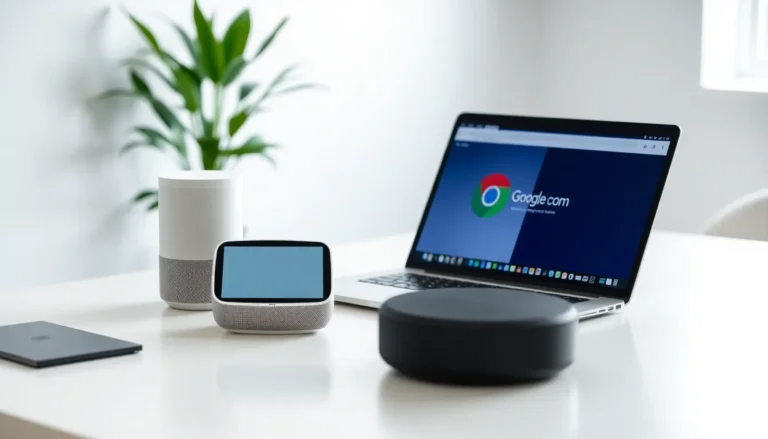Table of Contents
ToggleIn a world where everything seems to be getting smarter—phones, cars, even refrigerators—why should thermostats be left behind? Enter the smart thermostat, the unsung hero of home energy efficiency. These nifty gadgets not only learn your heating and cooling habits but also help you save money while keeping you cozy. Who knew that controlling the temperature could be this cool?
Overview Of Smart Thermostats
Smart thermostats significantly enhance home energy management by automating temperature adjustments. These devices utilize sensors and algorithms to monitor occupancy patterns, adjusting heating and cooling schedules based on user behavior. Energy savings often reach up to 10% to 30% per year, depending on usage.
Integration with smart home systems allows seamless connectivity with other devices. Many smart thermostats feature mobile apps, enabling remote control from smartphones or tablets. These applications can provide energy usage reports and insights, helping users make informed decisions about their consumption.
Learning capabilities set smart thermostats apart from traditional models. They adapt to user preferences over time, creating personalized heating and cooling schedules. This self-learning function can automatically adjust to seasonal changes, improving comfort effortlessly.
Installation options vary, with many models designed for DIY setup. However, professional installation may be necessary for complex systems or compatibility concerns. Common brands include Nest, Ecobee, and Honeywell, each offering unique features tailored to different user needs.
Overall, smart thermostats contribute to enhanced convenience and energy efficiency in modern homes. Their ability to learn and adapt ensures they meet individual preferences, promoting a comfortable living environment while reducing energy costs. As home automation continues to evolve, these devices play a crucial role in sustainable living practices.
Benefits Of Smart Thermostats
Smart thermostats offer several advantages that enhance home comfort and efficiency. They contribute significantly to energy management, cost reduction, and user control.
Energy Efficiency
Smart thermostats improve energy efficiency by utilizing advanced algorithms. These algorithms learn user habits and adjust temperatures accordingly. According to the U.S. Department of Energy, these devices can save 10% to 30% on heating and cooling costs annually. Sensors detect occupancy patterns and temperature preferences, optimizing heating or cooling based on when people are home. When paired with weather data, smart thermostats adjust accordingly, preventing energy waste.
Cost Savings
Cost savings represent one of the most compelling benefits of smart thermostats. Users experience reduced energy bills, particularly in homes with significant heating and cooling demands. The Energy Star program cites that homeowners can save, on average, about $175 annually. These savings often offset the initial cost of the device within a few years. Additionally, some utility companies offer rebates for installing energy-efficient thermostats, further enhancing financial benefits.
Convenience And Control
Convenience and control transform the user experience with smart thermostats. Many models come with mobile apps that allow remote adjustments. Users can create customized schedules, catering to their unique lifestyles. Voice control compatibility with smart assistants provides hands-free management. Notifications about energy usage encourage better habits, while integration with other smart home devices creates seamless interactions throughout the home.
Features To Consider
Smart thermostats offer a variety of features that enhance user experience and energy savings. When selecting a device, several factors warrant careful consideration.
Learning Capabilities
Learning capabilities are essential for optimizing energy use. Smart thermostats adapt to user schedules and preferences through machine learning algorithms. They analyze historical data, adjusting settings to promote comfort while minimizing energy waste. For instance, these devices can detect when occupants are home or away, making automatic adjustments that lead to significant energy savings. Such technology supports reductions in energy costs, often achieving savings between 10% and 30% annually.
Compatibility With Home Systems
Compatibility with existing home systems is crucial for seamless operation. Many smart thermostats integrate with various HVAC systems, ensuring broad usability. Additionally, Wi-Fi connectivity enables remote access and control, enhancing user convenience. Some models may link with smart home hubs, allowing interaction with devices such as smart speakers and home automation systems. Ensuring compatibility leads to efficient energy management and smooth operations throughout modern homes.
User Interface
An intuitive user interface enhances the overall experience with smart thermostats. Many devices feature touchscreens that provide easy navigation and clear visibility. Others have mobile apps that allow users to manage settings remotely, whether at work or on vacation. Customization options let users create schedules based on their unique needs, promoting comfort and efficiency. Voice control compatibility adds another layer of convenience, allowing for hands-free adjustments.
Popular Smart Thermostat Models
Smart thermostats come in various models, each offering unique features and benefits. These devices cater to different user needs while maintaining energy efficiency and convenience.
Model A Overview
Model A stands out with its advanced learning capabilities. It adapts to household schedules, adjusting temperatures accordingly for optimal comfort. An intuitive app provides remote access, letting users manage settings from anywhere. This model offers compatibility with various HVAC systems, enhancing usability. Users appreciate notifications about energy consumption, which help them track usage patterns. Notably, Model A reports average annual energy savings of about $175, making it a cost-effective choice for many households.
Model B Overview
Model B emphasizes seamless integration with smart home ecosystems. This model features voice control compatibility, allowing users to adjust settings hands-free through assistant devices. The customizable scheduling options cater to diverse lifestyle needs, enhancing overall convenience. Model B’s user-friendly interface simplifies navigation between settings and features. A notable aspect includes compatibility with a wide range of sensors, enabling precise temperature management. Users who opt for Model B can expect energy savings of 10% to 30%, reinforcing its investment value for households seeking efficiency.
Smart thermostats represent a significant advancement in home energy management. Their ability to adapt to user habits not only enhances comfort but also leads to substantial cost savings. By automating temperature adjustments and integrating with other smart home devices, they streamline energy usage and promote sustainable living.
As households increasingly embrace technology, investing in a smart thermostat becomes a practical choice. With features like mobile app control and voice compatibility, users can enjoy unprecedented convenience while reducing their energy bills. Ultimately, smart thermostats are more than just gadgets; they’re essential tools for modern living that contribute to both financial savings and environmental responsibility.







